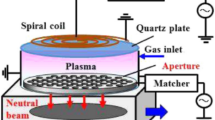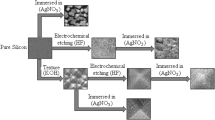Abstract
Si surface texturing generally requires an etching process to improve the anti-reflection and the self-cleaning properties of the surface. Among the various etching techniques for surface texturing, the wet etching method has been widely adopted as a relatively simple and inexpensive manufacturing method. In this study, we report the effects of hierarchical pyramid-structured Si with nanoholes formed using a chemical wet etching process with thermally dewetted Ag thin films. First, alkaline etching was performed on a Si wafer to fabricate micrometer-sized random pyramid structures. Then, Ag thin film was thermally grown on the pyramid-structured Si. Finally, nanopores were formed on the random pyramid structure via metal-assisted chemical etching. The final morphology of Si was a hierarchical random pyramid structure with nanoholes, exhibiting both anti-reflection and superhydrophobicity. The average reflectance decreased to ∼4%, and the contact angle increased to 170.5°, allowing these surfaces to be used in various wettability-controlled optoelectronic devices, such as Si solar cells for where light trapping and self-cleaning are essential.
Similar content being viewed by others
References
X. Li, Curr. Opin. Solid State Mater. Sci. 16, 71 (2012).
F. Toor et al., Nanotechnology 27, 412003 (2016).
E. Yu et al., Sci. Rep. 5, 9362 (2015).
B. He et al., Nano Today 8, 265 (2013).
Y. Xiu, L. Zhu, D. W. Hess and C. P. Wong, Nano Lett. 7, 11, 3388 (2007).
C. Q. Lai, W. Zheng, W. K. Choi and C. V. Thompson, Nanoscale 7, 11123 (2015).
X. Liu et al., Energy Environ. Sci. 7, 3223 (2014).
W. Liu et al., Micromachines (Basel) 9, 346 (2018).
B. Ki, K. Choi, K. Kim and J. Oh, Nanoscale 12, 6411 (2020).
H. K. Raut, V. A. Ganesh, A. S. Nair and S. Ramakrishna, Energy Environ. Sci. 4, 3779 (2011).
S. M. S. Shahabadi et al., J. Membr. Sci. 537, 140 (2017).
J-C. Woo, N. S. Baek, J. Y. Kim and C-I. Kim, RSC Adv. 2, 7677 (2012).
H. Xiang and K. Komvopoulos, J. Appl. Phys. 113, 224505 (2013).
S. Han, R. Yang, C. Li and L. Yang, Appl. Sci. 9, 566 (2019).
H. Y. Erbil and C. E. Cansoy, Langmuir 25, 14135 (2009).
Acknowledgments
This research was supported by Korea Electric Power Corporation (R19XO01-11). This work was also supported by the BB21+ project in 2020.
Author information
Authors and Affiliations
Corresponding author
Rights and permissions
About this article
Cite this article
Lee, H., Kim, H.J. Formation of Hierarchical Pyramid-structured Si with Nanoholes by Using Thermally Dewetted Ag Thin Films. J. Korean Phys. Soc. 77, 598–604 (2020). https://doi.org/10.3938/jkps.77.598
Received:
Revised:
Accepted:
Published:
Issue Date:
DOI: https://doi.org/10.3938/jkps.77.598




